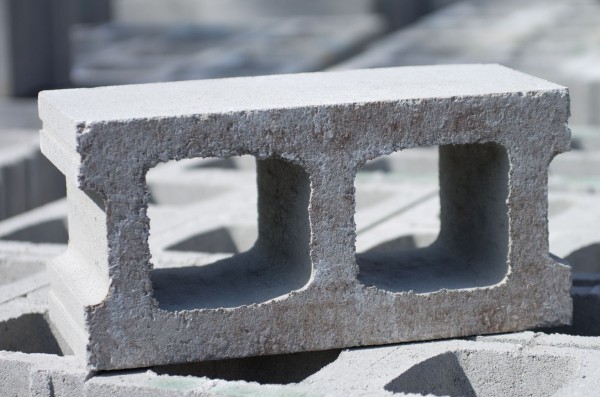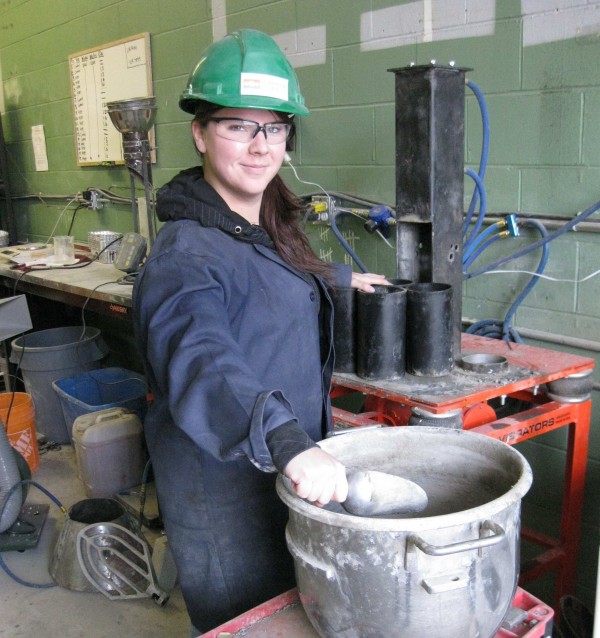Around the world, engineers are busy working out ways to reduce the carbon footprint of concrete, which accounts for somewhere between 3 and 7 percent of global carbon emissions. (We’ve written recently about self-healing concrete, bendable concrete, and concrete incorporating waste from ethanol production.)
A Nova Scotia startup named CarbonCure is already on line with a very direct approach: injecting waste carbon dioxide into the concrete-mixing process, which by nature takes CO2 and sequesters it as calcium carbonate. (The epitome of tried-and-true, CaCO3 has been the main terrestrial carbon sink for several billion years and running.)

Let me offer a little backgrounder on the chemistry involved.
Though various recipes bring in other elements, at the heart of concrete lies a simple mirror-image pair of chemical reactions involving just carbon, oxygen, and calcium. First, cement is manufactured from limestone in a kiln. The limestone (CaC03) is heated until its splits into CO2 (driven into the air) and quicklime (CaO), the key component of cement. Later, the cement is made into concrete by mixing cement with water and bulk ingredients, mainly sand and gravel. The water contains dissolved CO2, which recombines with the CaO to form limestone all over again. To a lesser degree, the concrete continues over the following decades to draw more CO2 out of the air and sequester it as more limestone.
CarbonCure’s technology simply crams a little more CO2 into the concrete, sooner. The best part is that the result is stronger, and reaches full strength before it leaves the factory; this strength should make it possible to design any given project to use less concrete.
Since CarbonCure envisions obtaining all the CO2 directly from industrial emitters who want to lower their emissions, they are perhaps helping create source-to-sink pathways for the stuff. I’m not sure that’s ultimately any better than sucking it out of the atmosphere, but whatever.
Bottom lines: ALL concrete “sequesters” some carbon as limestone; NO concrete sequesters anywhere near as much as it already emitted during its production process, both from the chemical reaction and from burning fossil fuels to heat the kiln. Concrete will remain a huge carbon source.
CarbonCure and many other “green” companies are whittling away at concrete’s carbon numbers. (Taking a little pumice to the old footprint?) That’s a good thing, up to a point. If you’re in the market for concrete blocks in Ontario, seek out Atlas blocks. (On the West Coast, similar blocks may be available from Basalite.) And if you’re in the market for ready-mix (poured on site) concrete a year from now, find out if you can get it with CarbonCure. The ready-mix market is much larger than the concrete block market, and CarbonCure is ambitiously moving forward with applying their technology to ready-mix; they expect to demo that within a few months.
What’s even more important, if you’re using new improved concrete, is to make sure you take advantage of its greater strength by reducing the amount of concrete you use. And still better, carefully consider lower-carbon alternatives to concrete.

So far this year, CarbonCure’s best customer is Atlas Block, a family-owned concrete product manufacturer in Ontario. Atlas Block had previously made sustainability waves by developing a way to recycle colored glass waste in concrete. Atlas is now converting their entire production of blocks to use CarbonCure.
The deal between Atlas and CarbonCure got a lot of good online press this spring. Unfortunately, some of it came off as “Wow! They figured out a way to sequester carbon in concrete! Carbon-negative concrete may be just around the corner!” CarbonCure itself isn’t trying to mislead anyone; their VP of marketing, Jennifer Wagner, was very helpful to me in clarifying the technology and the grounds for long-term optimism:
“Carbon negative concrete could potentially be achieved by integrating low-carbon materials such as fly ash, slag, low-carbon cements (Lafarge has developed one called Aether), low-carbon aggregates (Carbon8 is an example) as well as direct carbon sequestration technologies (such as CarbonCure’s technology).”